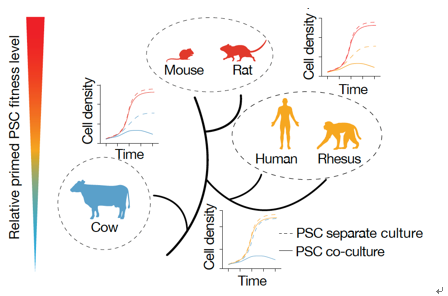A New Paradigm of Stem Cell Competition between Interspecies Was Discovered
January 30, 2021 - A team led by The First Affiliated Hospital, Sun Yat-sen University, UT Southwestern Medical Center and BGI-Shenzhen have identified a new paradigm of stem cell competition between interspecies. This finding, reported online in Nature on January 28, 2021, paves the way for studying evolutionarily conserved mechanisms underlying competitive cell interaction during early mammalian development.
Scientists have long known that Pluripotent stem cells (PSCs) provide an invaluable in vitro model to study early mammalian development, and hold great potential in revolutionizing regenerative medicine. More recently, PSC-derived interspecies chimeras have provided a means to generate complex three-dimensional tissues in vivo, which may help overcome the world-wide shortage of donor organs for transplantation. Although interspecies chimeras with extensive donor cell contribution have been achieved among several rodent species, low levels of chimeric contribution from donor PSCs were detected in evolutionarily distant host species, even at early developmental stages. During mammalian embryonic development, a wide range of cellular changes take place, including a dramatic increase in proliferation rate and a rewiring of the transcriptional, epigenetic, metabolic and signaling networks. The precisely orchestrated timing and complexity of these changes provide significant potential for the emergence of aberrant cells, which are subsequently eliminated to ensure unperturbed development. During interspecies chimera formation, xenogenic PSCs may be treated as unfit or aberrant cells and targeted for elimination. To date, however, cell competition has not been examined in an interspecies context during early development due to lack of an?in vitro?model.
In this latest research, Dr. ZHENG Canbin in Jun Wu’s lab and his colleagues developed an interspecies PSC co-culture strategy and uncover a previously unknown mode of cell competition between species. They labeled FR-cultured human H9 embryonic stem cells (ESCs) and mouse epiblast stem cells (mEpiSCs) with Enhanced Green Fluorescent Protein (EGFP) and monomeric Kusabira Orange (mKO), respectively. Time-lapse confocal microscopy was performed on co-cultured H9 ESCs and mEpiSCs. Interestingly, they observed that, after coming into contact with mEpiSCs, many H9 ESCs underwent apoptotic cell death. This is the first time to demonstrate competitive interaction between co-cultured human and mouse primed PSCs, and “winner” mEpiSCs induced the elimination of “l(fā)oser” human PSCs. Later they found this kind of interspecies PSC competition occurs during primed but not na?vepluripotency. They also extended primed PSC competition beyond human and mouse and suggest it is a more general phenomenon between evolutionarily distant species (Fig. 1).

Fig 1. Schematic summary showing the hierarchy of “winner” and “l(fā)oser” species during interspecies primed PSC competition.
Through comparative transcriptome analysis, they found?genes related to the NF-κB signaling pathway, among others, were?upregulated?in loser cells. Genetic inactivation of a core component (P65) and an upstream regulator (MYD88) of NF-κB complex in human cells could overcome interspecies PSC competition. Suppressing interspecies PSC competition significantly improved the survival of human cells in early mouse embryos. Recently, apoptosis was recognized as an initial barrier of interspecies chimerism, and forced expression of anti-apoptotic factors including BCL-2 and BMI1 improved primed human PSC chimerism in early mouse and pig embryos. This study provided mechanistic insights linking human cell death to interspecies cell competition during primed pluripotency. They establish a novel platform to study evolutionarily conserved cell competition mechanisms during early mammalian development, and when combined with other strategies, e.g. blastocyst complementation and novel PSC and embryo cultures, may overcome the xenogeneic barrier and lead to successful interspecies organogenesis in an evolutionarily distant host
The first author, Dr. ZHENG Canbin says, “This is a beautiful study that overcome the xenogeneic barrier and lead to successful interspecies chimeras generated between different specieswill help gain knowledge of evolutionarily conserved and divergent developmental mechanisms, provide novel insights into size and timing control and other species-specific traits, and most recently generate hope for solving the world-wide shortage of donor organs via interspecies organogenesis.”
Dr. ZHENG Canbin is from Department of Microsurgery, Orthopedics, Trauma and Hand Surgery, The First Affiliated Hospital, Sun Yat-sen University. He has worked in Jun Wu’ lab as visiting scholar in Department of Molecular Biology, University of Texas Southwestern Medical Center since 2018. Jun Wu is the correspondent author in this study. Other researchers who have contributed to this study include Yingying Hu, Masahiro Sakurai, Carlos A. Pinzon-Arteaga, Leqian Yu, Jie Li, Yulei Wei, Daiji Okamura, Benjamin Ravaux, Haley Rose Barlow, Elizabeth H. Chen, Ondine Cleaver, Hai-Xi Sun, Ying Gu.
?
Link: https://www.nature.com/articles/s41586-021-03273-0
?

